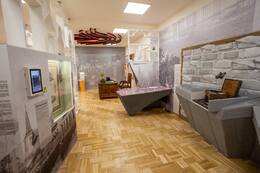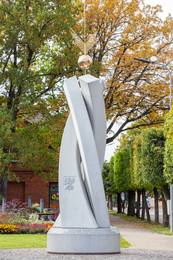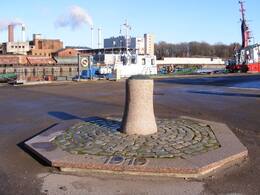Latvian Provisional National Council (LPNP)
I WW1, I Wars of Independence
Latvian Provisional National Council (LPNP) - an organization of Latvian political representation, founded in November 1917 in Valka (English Latvian Provisional National Council, German Lettlands Vorläufiger Nationaler Rat, Russian Латышский временный национальный совет).
LPNP was delegated by Latvian political parties and public organizations. Until the meeting of the Latvian People's Council (November 17, 1918), this organization defended the right of self-determination of the Latvian people internationally. The aim of the LPNP was to stand up for the Latvian nation united in a unified and ethnographic territory, to represent its interests at the next peace conference and to take care of the convening of the Constitutional Assembly. Its tasks are to convene the Latvian Constitutional Assembly, which would decide on Latvia's internal system and "external relations"; to ensure the return of the scattered people to their homeland; to protest against any attraction of Latvia to Germany; to demand the separation of Latgale from the Vitebsk province and its annexation to Latvia.
On November 17, 1917 (November 30, 1917), 29 delegates from 13 civic parties and organizations were established in Valka LPNP . After the establishment, the 1st session of the LPNP began, which lasted until 19.11. (19.12.J.). , is an autonomous state unit, the position of which, in relation to the exterior and internal equipment, will be determined by her Constitutional Assembly and the people's plebiscite. ”
19.11. (J.st.02.12) .1917. elected the LPNP board. Voldemārs Zāmuelis, a lawyer, Kārlis Paļuks, a lawyer, Jānis Rubulis, a podporic, and Jānis Palcmanis, a soldier, were elected chairman; for the secretary - notary Kristaps Bahmanis, for the members of the secretary - writers Kārlis Skalbs and Jānis Akuraters; for the treasurer - cooperator Vili Siliņš, for the treasurer - commercial engineer Eduards Laursons.
On November 25, 1917, the LPNP issued a call to "All Latvians!", Which was distributed in 30,000 copies in the German-occupied part of Latvia and in Latvian refugee centers in Russia. In the invitation, LPNP informed about its establishment and called on Latvians to exercise their right to self-determination. 12/19/1917 (01.01.1918) the school was banned from the LPNP and its board continued to operate illegally. The Foreign Affairs Division of the organization operated in Petrograd. 1/1/1918 The 2nd session of the LPNP was held in 2006. In the adopted declaration, the goal was set for the first time that “Latvia should be an independent democratic republic that would unite Kurzeme, Vidzeme and Latgale”.
In October 1918, discussions began between the LPNP and the Democratic Bloc established in German-occupied Riga on the establishment of the Latvian Parliament. On November 17, 1918, the last meeting of the LPNP Board was held, at which it was decided not to obstruct the establishment of the Latvian People's Council, which would proclaim the Republic of Latvia on November 18. The LPNP therefore ceased to exist.
More information sources
Jānis Tomaševskis. Whispers of Independence: History of the Latvian Provisional National Council, Riga, Jumava, 2017; Jānis Tomaševskis. Latvian Provisional National Council. National Encyclopedia. https://enciklopedija.lv/skirklis/27579-Latvie%C5%A1u-pagaidu-nacion%C4%81l%C4%81-padome
Related timeline
Related objects
Exhibition “Valka - the Cradle of Latvia’s Independence”
The Valka Local History Museum is located in Valka, on the right side of Rīgas street, in the historical building of the Vidzeme Parish School Teacher Training Seminary. From 1853 to 1890, the building was home to the Vidzeme Parish School Teacher Training Seminary. Until 1881, it was led by Jānis Cimze, a teacher and founder of Latvian choir culture. After the School Teacher Training Seminary was closed, the building served various educational, cultural and household needs for 80 years. The building has been home to the Valka Local History Museum since 1970. The museum’s permanent exhibit – ‘Valka, the Cradle of Latvia’s Independence’ – has been set up as a story about social and political events in Valka from 1914 to 1920 when Latvia became an independent state. The exhibit reflects the preparation leading up to the establishment of the Latvian state and the formation of the North Latvian Brigade in Valka. Through four senses, namely, the Road, the Council, the Headquarters and the Home, the exhibit focuses on topics related to the city of Valka, refugees, the founding of the Latvian Farmers’ Union (1917), the
Latvian Provisional National Council (1917), the Latvian Provisional National Theatre (1918), the Provisional Government of Soviet Latvia known as the Iskolat, the North Latvian Brigade (1919) and General Pēteris Radziņš. In addition to the traditional ways of showcasing collections, the exhibit makes use of interactive multimedia solutions.
Monument "Dedication to the Latvian Provisional National Council"
The monument “Dedication to the Latvian Provisional National Council” is located at the intersection of Rīgas and Raina streets in Valka (address 9A Raina Street).
The monument was unveiled on December 2, 2017 within the framework of the Latvian Centennial Program, in honor of the meeting of the Latvian Provisional National Council in 1917.
The author of the idea of the ensemble is the sculptor Arta Dumpe, the stonemason - Ivars Feldbergs, the architectural planning was performed by SIA "Arhitektu birojs Vecumnieks & Bērziņi".
The base of the monument is formed by a large millstone - as a circle of life, time and events. The names of the members of the LPNP board are engraved on the side. Three counties with their historical coats of arms wind from the millstone as roads of destiny in the sky. Vidzeme, Kurzeme and Latgale. The composition concludes with the star of Bethlehem, which transforms into the sun of the new Latvian state. The Latvian poet, prose writer and politician Kārlis Skalbe / 1879-1945 / has written: "Latvia has also had its own Bethlehem, the little poor Valka ...".
The monument to the Latvian Provisional National Council is the return of a kind of debt to the people who, in 1917, risking their lives in Valka, laid the foundations for the Latvian state in an ideally managed, virtually impossible situation.
At that time, Valka was the city with the largest population of Latvians in the unoccupied territory of Germany. After the fall of Riga, it became the center of Latvian social, political and cultural life. Those who were united by the desire to exercise the right of self-determination of the Latvian nation gathered here. From November 29 to December 2, 1917 (according to the new style) the 1st session of the Latvian Provisional National Council took place in Valka City Hall (now the building in Valga Kesk Street No. 11), which was attended by representatives of almost all the most influential Latvian public organizations and political parties. . For the first time, they officially declared the goal of their activity - the establishment of an independent national state, adopted a declaration on the establishment of a united and autonomous Latvia in the Latvian districts of Vidzeme, Kurzeme and Latgale.
Berth of the ship "Saratov" in Liepaja
The berth of the "Saratov" is located in Liepaja, at 59 Old Harbour, near the boat docks.
Built in 1888 in Copenhagen by the shipyard Buvmeistar & Wain under the name "Leopold II", in 1911 it was bought by the joint-stock company Russian North-West Shipping and renamed "Saratov", with the Latvian Aleksandrs Remess becoming the ship's captain.
In May 1915, when Liepaja was occupied by German troops, the Saratov was in a damaged state in the harbour.
On 10 January 1919, the steamship Saratov was taken over by the Latvian Provisional Government. From April to July 1919, after the "16 April coup d'état", the Provisional Government headed by K. Ulmanis was on board the Saratov and was forced to take refuge under the protection of the Allied fleet.
On 8 July 1919, after the delivery of the Provisional Government of K. Ulmanis to Riga, the steamers were used for traffic between Riga, Ventspils and Liepaja.
Under the terms of the Peace Treaty of 11 August 1920 between Latvia and Soviet Russia, the steamship Saratov had to be returned to the Soviet side. On 2 January 1923, the steamship was handed over to a Soviet Russian representative. On 15 January 1923, the steamship "Saratov" was wrecked off Akmenrags.
In 1936 the Latvian Maritime Department sold the wreck to a company, which scrapped it and handed it over to the Liepaja Cloth Factory.
Rubenis' battalion museum
Rubenis’ Battalion Museum is located in Ugāle. It is dedicated to the Battalion of R. Rubenis, who served and fought under General J. Kurelis in Kurzeme in 1944, the activities of the Kurelians and the national resistance movement. Museum has an exhibit on the activities of the Latvian Central Council (LCC) and its Ventspils group, as well as the LCC Memorandum with 188 signatures and photographs of signatories that is included in the Latvian National Register of the UNESCO Memory of the World Programme. The LCC was a joint centre of Latvia's highest political leadership with an underground government that operated during the occupation of Latvia from 1943 to 1994. It was formed with the aim of coordinating the activities of various Latvian resistance movements in order to restore Latvia's national independence. The museum also offers a trip to places significant to the history of the battalion (settlement with a reconstructed bunker in the Usma parish, battlefields in Renda and Zlēkas parishes, etc.).
Related stories
March 1917 - an important month in the history of Valmiera and Latvia
In March 1917, more than a year before the proclamation of the State of Latvia, the Vidzeme Provisional Land Council was founded in Valmiera, which adopted a resolution on Latvia's right to autonomy and self-determination. On the day of the founding of the Council, a red-white-red flag was raised at the meeting place for the first time.
Memories of Artūrs Ozols about the ship "Saratov"
Artūrs Ozols graduated from Riga Polytechnic and served as a naval officer (midshipman) and engineer in the Russian Black Sea Fleet aboard the warship Panteleimon. During the Latvian Liberation Struggle, he joined the Student Company. In Liepaja he put the ship "Saratov" into service. Arthurs Ozols' memoirs about the ship "Saratov" were published in the Dauagava Vanagi monthly
From Adolf Ers' book "Vidzeme in the Freedom Fights" about the life of refugees in Valka
From the time of the refugees, Valka agreed to play a more important role than other cities in Vidzeme, because the politically active newspaper Līdums was located here, where Latvia's spiritual and political weapons were minted, and also because there was a crossroads where roads from three On the Latvian side: from Riga, Alūksne, Mozekile, and also from Estonia and Russia, she had links with refugees everywhere - in Tartu, Pliskava, Moscow and St. Petersburg. There was a large refugee center here.
Cape and ship Saratov
It can be assumed that Liepaja was the capital of Latvia for a short period of time, because during the Freedom Struggle the Provisional Government was stationed on the ship Saratov in this very city. The Saratov took the Provisional Government to Riga after its liberation, but many people do not know that the history of such an important ship for us ended at sea at Akmenrags.
Akmeņrags lighthouse and shoal - one of the largest ship cemeteries in the Baltic Sea
It was in the Akmensrags lighthouse area that on January 13, 1923, a steamer Saratov ran aground and crashed, on which the interim government, led by K. Ulmanis, took refuge, when the independent state of Latvia became independent.









